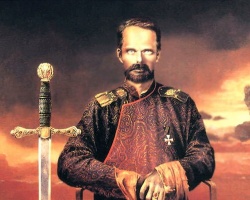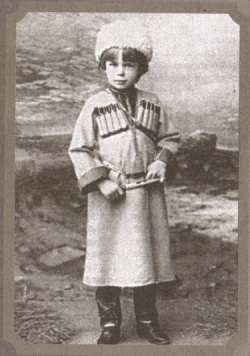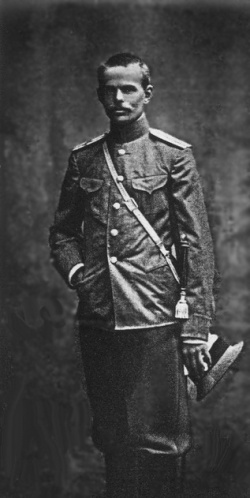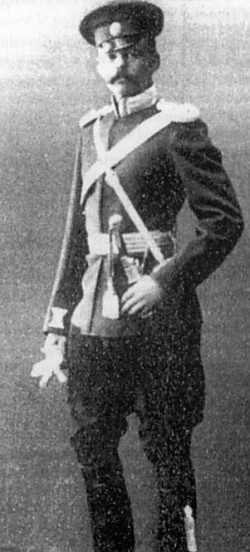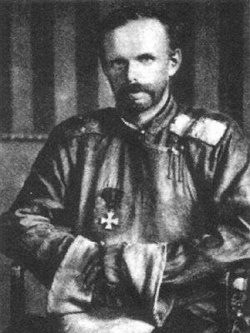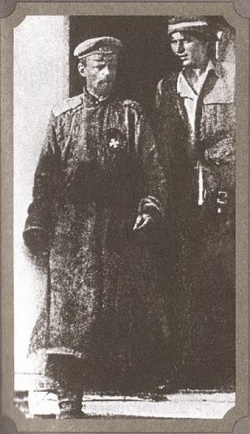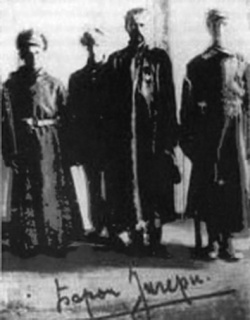Roman von Ungern-Sternberg
Baron Roman Nikolai Maximilian von Ungern-Sternberg (Russian: Барон Ро́берт-Ни́колай-Максими́лиан Рома́н Фёдорович фон У́нгерн-Ште́рнберг) Russian name:
Роман Фёдорович фон Унгерн-Штернберг, which transliterates as Roman Fyodorovich fon Ungern-Shternberg (December 29, 1885 – September 15, 1921)
was an anti-Bolshevik Lieutenant General in the Russian Civil War and then an independent warlord whose Asiatic Cavalry Division wrested control of Outer Mongolia from occupying Chinese forces in 1921.
Ungern-Sternberg's attraction to mystic Buddhism and his eccentric, often violent treatment of enemies as well as his own troops earned him the sobriquet "the Mad Baron" during the Russian Civil War.
He was also an arch conservative pan-monarchist and pan-mongolist who aspired to restore the Russian monarchy under Michael Alexandrovich Romanov and revive the Great Mongol Empire under the rule of the Bogd Khan.
During his short five month occupation of Outer Mongolia, Ungern-Sternberg imposed order on the capital Ikh Khüree through fear, intimidation, and brutal violence against opponents, particularly Bolshevik supporters.
His subsequent invasion of Southern Siberia in support of anti-Bolshevik rebellions and to head off a Red Army-Mongolian partisan invasion in June 1921 ultimately led to his defeat and capture two months later.
He was taken prisoner by the Red Army and tried for counterrevolution in Novonikolaevsk in 1921. After a six hour show trial he was found guilty and executed on September 15, 1921.
R.F. von Ungern-Sternberg was born in Graz, Austria on December 29, 1885 to a noble Baltic German family.
His mother was Sophie Charlotte von Wimpffen, later Sophie Charlotte von Ungern-Sternberg, and his father was Theodor Leonhard Rudolph von Ungern-Sternberg (1857–1918).
In 1888 his family moved to Tallinn (Reval), the capital of Estonia (then part of the Russian Empire), where his parents divorced three years later in 1891. In 1894 his mother married Oskar Anselm Herrmann von Hoyningen-Huene.
From 1900 to 1902 Ungern attended the Nicholas I Gymnasium, Tallinn. In 1903 he enrolled in Marine Officers Cadet School in St. Petersburg.
In 1905 he left the school to join the fighting in Eastern Russia during the Russian-Japanese war, but it is unclear whether he participated in operations against the Japanese, or if all military operations had ceased before his arrival in Manchuria.
In 1906, Ungern was transferred to service in Pavlovskoe Military School in St. Petersburg as a cadet of ordinary rank.
After graduating he served as an officer in East Siberia in the 1st Argunsky and the 1st Amursky Cossack regiments, where he became enthralled with the lifestyle of nomadic peoples such as the Mongols and Buryats.
In 1913, at his request, he was transferred to the reserves. Ungern moved to Outer Mongolia to assist Mongols in their struggle for independence from China, but Russian officials prevented him from fighting with Mongolian troops.
He arrived in the town of Khovd in western Mongolia and served as out-of-staff officer in the Cossack guard detachment at the Russian consulate.
First World War
On July 19, 1914 Ungern joined front-line forces as part of the second-turn 34th regiment of Cossack troops stationed on the Austrian Front in Galicia (today's territories of southern Poland and western Ukraine).
Ungern took part in the Russian offensive in Eastern Prussia, where in 1915-1916 he participated in rear-action raids on German troops by the L.N. Punin Cavalry Special Task Force.
During the war, Ungern gained a reputation as a brave but somewhat reckless and mentally unstable officer.
Although decorated with several military awards, he was eventually discharged from one of his commanding positions for failing to obey orders.
General Wrangel mentions Ungern's determination in his memoirs.
After the February Revolution in 1917, Ungern transferred to the Caucasian theater of war, where Russia was fighting with Turkey.
In April 1917 near Urmia, Iran, Ungern, together with Grigori Semenov, started to organize a volunteer squad of local Assyrians.
The Assyrians scored minor victories under Ungern's command, but their contribution to Russia's war effort was limited.
Bolshevik Revolution, 1917
After the Bolshevik-led October Revolution of 1917, Semenov and Ungern declared their allegiance to the Romanovs and vowed to fight the revolutionaries.
Semenov, who was backed by the Japanese, appointed Ungern governor of Dauria, the large area to the east southeast of Lake Baikal.
In the months that followed, Ungern distinguished himself by his exceedingly eccentric behavior, which lead many to dub him the "Mad Baron."
Semenov and Ungern, though fervently anti-Bolshevik, were not part of the White movement and Semenov refused to recognize the authority of Admiral Aleksandr Kolchak, the nominal leader of the Whites in Siberia.
Instead, he acted independently, supported by the Japanese with arms and money.
For White leaders like Kolchak and Denikin, who believed in a "Russia strong and indivisible", this was high treason. Ungern was nominally subordinated to Semenov but acted independently.
Because of his successful military operations in Hailar and Dauria, Ungern received the rank of Major-General. Semenov appointed him commandant of the Dauria railway station and entrusted him with forming military units to battle Bolshevik forces.
In Dauria, Ungern formed the volunteer Asiatic Cavalry Division (translated from the native Russian "Азиатская конная дивизия"), a mix of Russians, Buryats, Tatars, Bashkirs, Mongols from different tribes, Chinese, Manchu, Japanese, Polish exiles and many others.
Several authors, such as Robert de Goulaine and Hugo Pratt, refer to Ungern's unit as "The Savage Division" (the accurate translation of the native Russian "Дикая дивизия"), a name also used at the time by both Ungern and his contemporaries.
The Savage Division properly referred to the military unit consisting of mountain peoples from the Caucasus or Mongolic Kalmyks in the Russian Imperial Army, which fought in World War I and later, after the Russian Revolution, against Bolsheviks.
Ungern reinforced his military station at Dauria, creating a kind of fortress from where his troops launched attacks on Red forces.
Like many other White units, Ungern's troops employed plundering as source of their supply. They plundered trains passing through Dauria to Manchuria.
While these confiscations did not significantly diminish supplies of the Kolchak's forces, private Russian and Chinese merchants lost considerable property.
Ungern believed that monarchy was the only social system which could save Western civilisation from corruption and self-destruction.
He began to pursue the idea of restoring the Genghis Khan's Mongolian Empire with the Qing Dynasty providing the most appropriate candidate for the throne.
Ungern sought to organize a military expedition to Mongolia, at that time occupied by the Chinese troops formerly led by General Xu Shuzheng a member of the Pro Japanese Anhui Clique in the Chinese government, to restore the rule of the Bogd Khan as part of his plan to re-establish monarchies from the Far East to Europe.
The Japanese were the ones who ordered the pro Japanese Chinese warlords to occupy Mongolia in order to halt a possibly revolutionary spillover from the Russian revolutionaries into Mongolia and Northern China.
1919, a Japanese influenced faction in the Chinese government mounted an invasion of Outer Mongolia and forced its leaders to sign a "request" to be taken over by the government of China.
Japan's aim was to protect its own economic, political, and military interests in North China be keeping the Russian Revolution from influencing Mongolia.
After the fall of the Anhui Clique, Chinese soldiers in Mongolia were effectively abandoned.
They rebelled against their commanders, and plundered and killed Mongols and foreigners.
As part of his plans, Ungern traveled to Manchuria and China proper in February through September 1919.
There he established contacts with monarchistic circles, and also made preparations for Semenov to meet with the Manchurian warlord Zhang Zuolin.
In July 1919 Ungern married the Manchurian princess Ji in an Orthodox ceremony. The princess was given the name Elena Pavlovna Ungern-Sternberg.
They communicated in English.
This marriage had a political aim as Ji was a princess and a relative of General Zhang Kuiwu, commander of Chinese troops at the western end of the Chinese-Manchurian Railway (in Russian: KVZhD), and governor of Hailar.
Restoring Independence of Outer Mongolia
After Kolchak's defeat at the hands of the Reds and the subsequent decision of Japan to withdraw its expedition troops from Transbaikalia, Semenov, unable to withstand the pressure of Bolshevik forces, planned a retreat to Manchuria.
Ungern, however, saw this as an opportunity to implement his monarchistic plan. On 7 August 1920, he broke his allegiance to Semenov and transformed his Asiatic Cavalry Division into a guerrilla detachment.
Ungern's troops crossed the northern border of Outer Mongolia on October 1, 1920 and moved south-westwards .
Ungern entered negotiations with Chinese occupying forces.
All of his demands, including disarmament of the Chinese troops were rejected.
On October 26–27 and again on November 2–4, 1920 Ungern's troops assaulted Mongolia's capital, Urga (official name at that time was Niislel Khuree; now Ulaanbaatar) but suffered tremendous losses.
After the defeat, Ungern's troops retreated to the upper currents of the Kherlen River in Setsen-Khan Aimag (district ruled by princes with the title Setsen Khan) of in eastern Outer Mongolia.
He was supported by Mongols who sought independence from Chinese occupation, especially the Bogd Khan, who secretly sent Ungern his blessing for expelling Chinese from Mongolia.
The Chinese had tightened their control of Outer Mongolia by this time, strictly regulating Buddhist services in monasteries and imprisoning Russians and Mongols who were considered "separatists".
According to memoirs by M.G. Tornovsky, the Asiatic Division numbered 1460 men, while the Chinese garrison was seven thousand men strong.
The Chinese had the advantage in artillery and machine guns, and had built a network of trenches in and around Urga
On February 1, 1921, Ungern's detachment, led by B.P. Rezukhin, captured Chinese front-line fortifications.
Other troops moved to Urga and to the Manjusri Monastery on Bogd Khan Uul mountain south of Urga. On February 2, Ungern's troops battled for control of Chinese front lines and secured parts of Urga.
During the battle Ungern's special detachment of Tibetans, Mongols, Buryats and Russians rescued the Bogd Gegeen from house arrest and transported him through the Bogd Uul to Manjusri Monastery.
On February 3, Ungern gave his soldiers a respite.
Borrowing a tactic from Genghis Khan, Ungern ordered his troops to light a large number of camp fires in the hills surrounding Urga, using them as reference points for Rezukhin's detachment.
This also made the town appear to be surrounded by an overwhelming force.
On February 4, Ungern launched a major assault on remaining Chinese positions in Urga from the east, capturing the most fortified positions at the barracks and the Chinese trade settlement (Template:Lang-zh, Maimaicheng).
The entire capital was finally taken after several fierce battles, although a part of Chinese troops had abandoned the town earlier. Nevertheless, small battles continued through February 5.
Between March 11 and 13 Ungern captured a fortified Chinese base at Choir south of Urga; while Zamyn-Üüd was abandoned by the Chinese soldiers without battle.
When remaining Chinese troops, having retreated to northern Mongolia near Kyakhta, then attempted to round Urga to the west in order to reach China, Russians and Mongols feared an attempt to re-capture Urga.
Several hundred Cossack and Mongol units were dispatched to meet the Chinese troops of several thousand strength in the area of Urga - Uliastai road near the Tuul river in central Mongolia.
There battles raged from March 30 to April 2, the Chinese troops were routed and pursued to the southern border of the country.
Thus, Chinese forces have left Outer Mongolia.
Mongolia before the entry of Bolsheviks, 1921
Ungern, Mongolian lamas and princes brought the Bogd Khan from Manjusri Monastery to Urga on February 21, 1921.
On February 22, there was a solemn ceremony restoring the Bogd Khan to his rightful throne.
As a reward for ousting the Chinese from Urga, the Bogd Khan granted Ungern the high hereditary title darkhan khoshoi chin wang in the degree of khan, and other privileges.
Other officers, lamas and princes who had participated in these events also received high titles and awards.
For seizing Urga, Ungern received from Semenov the rank of Lieutenant-General. Mongolia was proclaimed an independent monarchy under the theocratic power of Bogd Khan, or the 8th Bogd Gegen Jebtsundamba Khutuktu.
Ungern accepted Buddhism without fully renouncing his Christianity. He declared himself a subject of Mongolia.
His traditionalism and orientalism, quite atypical for Western culture at that time, contributed to his reputation as the "Mad Baron".
Historians note that Ungern was viewed as the incarnation of the "Go of War", a deity absent in the Buddhist pantheon but existent in some folk traditions of Tibetan Buddhism as Jamsaran, "God of War".
Although many Mongols may have believed him to be a deity, or at the very least an incarnation of Genghis Khan, Ungern was never officially proclaimed to be any of these incarnations.
The widespread view that Ungern became "khan" or "dictator" of Mongolia is incorrect.
The title "khan" granted to Ungern by the Bogd Khan was solely an honorific one, without any political power.
Full power over Mongolia belonged to the Bogd Khan and his government.
According to some eyewitnesses (his engineer and officer Kamil Gizycki, and adventurer and writer Ferdynand Antoni Ossendowski, etc.)
Ungern was the first to institute order in Urga; imposing street cleaning and sanitation, and promoting religious life and tolerance in the capital, and attempting to reform the economy.
His Asiatic Cavalry Division consisted of national detachments, such as the Chinese regiment, Japanese unit, various Cossacks regiments, Mongol, Buryat, Tatar and other peoples' units.
Ungern said that 16 nationalities served in his division. Dozens of Tibetans also served as part of his troops.
They might have been sent by 13th Dalai Lama, with whom Ungern communicated, or these Tibetans may have belonged to the Tibetan colony in Urga.
They were essential in securing and protecting the Bogd Khan during the battle for Urga.
Defeat, capture, and execution, 1921
The Bolsheviks started infiltrating Mongolia shortly after the October revolution 1917, i.e. long before they took control of the Russian Transbaikalia.
In 1921, various Red Army units belonging to Soviet Russia and its satellite state of the Far Eastern Republic invaded newly-independent Mongolia to defeat Ungern.
These forces included the Red Mongolian leader and independence hero Damdin Sükhbaatar.
Spies and various smaller diversionary units were sent ahead to spread terror and betrayal to weaken Ungern's forces. Ungern organized an expedition to meet these forces in Siberia and support ongoing anti-Bolshevik rebellions.
Believing he had the unwavering popular support of locals in Siberia and Mongolia, Ungern failed to properly strengthen his troops despite being vastly outnumbered and out-gunned by the Red forces.
However, unbeknownst to Ungern, the Reds had successfully crushed uprisings in Siberia, and the economic policies of Soviet power had been temporarily softened. Upon Ungern's arrival, few local peasants and Cossacks volunteered to join him.
In the spring the Asiatic Cavalry Division was divided into two brigades: one under the command of Lieutenant-general Ungern and the second under Major-General Rezukhin.
In May, Rezukhin's brigade launched a raid beyond the Russian border to the west of the Selenge River.
Ungern's brigade left Urga and slowly moved to the Russian town of Troitskosavsk (now Kyakhta in Buryatia).
Meanwhile, the Reds moved big forces towards Mongolia from different directions.
They had a tremendous advantage in equipment (armored cars, airplanes, rail, gunboats, ammunition, human reserves, etc.) and number of troops. As a result, Ungern was defeated in battles that took place between June 11 and 13 and failed to capture Troitskosavsk.
Then the combined Bolshevik and Red Mongol forces entered Mongolia and captured Urga after a few small skirmishes with Ungern's guard detachments.
Having captured Urga on July 6, 1921, the Red forces failed to defeat the main forces of the Asiatic Division (Ungern's and Rezukhin's brigades).
Ungern regrouped and attempted to invade Transbaikalia across the Russo-Mongolian border.
To rally his soldiers and local people, Ungern quoted an agreement with Grigory Semyonov and pointed to a supposed Japanese offensive which was to support their drive, although neither Semenov, nor Japanese were eager to assist him.
After several days rest, on July 18, the Asiatic Division started its raid into Soviet territory.
Eyewitnesses Kamil Giżycki and Mikhail Tornovsky gave similar estimations of their numbers: about 3 thousand men in total. Ungern's troops penetrated deeply into the Russian territory.
The Soviets declared martial law in areas where the Whites were expected, including Verkhneudinsk (now Ulan-Ude, the capital of Buryatia).
Ungern's troops captured many settlements; the northernmost being Novoselenginsk, occupied by them on August 1. By this time, Ungern understood that his offensive was ill-prepared; he also heard about the approach of large forces of the Reds.
On August 2, 1921 he began his retreat to Mongolia, where he declared his determination to fight Communism.
While Ungern's troops wanted to abandon the war effort and head towards Manchuria to join with other Russian émigrés, it soon became clear that Ungern had other ideas.
He wanted to retreat to Tuva, then to Tibet.
Troops under both Ungern and Rezukhin effectively mutinied and hatched plots to kill their respective commanders.
On August 17, Rezukhin was killed. A day later conspirators unsuccessfully tried to assassinate Ungern.
His command then collapsed as his brigade broke apart.
On 20 August Ungern was captured by the Soviet detachment led by the famous guerrilla commander P.E. Shchetinkin (later a notorious member of the Cheka).
After a 6 hour and 15 minute show trial on 15 September 1921, prosecuted by Yemelyan Yaroslavsky, the Baron was sentenced to execution by firing squad.
The sentence was carried out that very evening or night in Novonikolaevsk.
"When he learnt of his death, the Bogd Khan ordered prayers for his soul to be read throughout Mongolia. They were undoubtedly needed." </poem>
